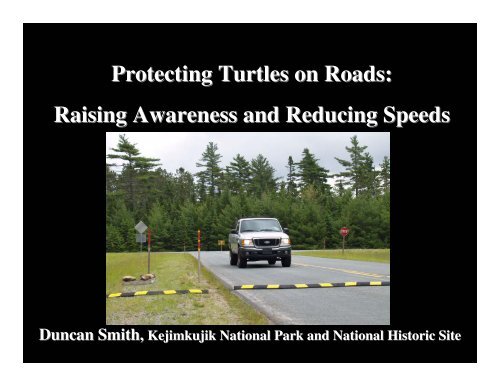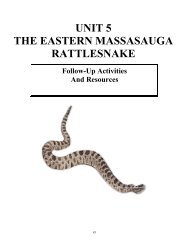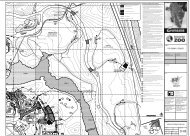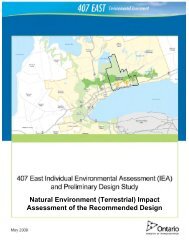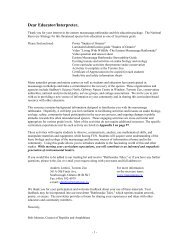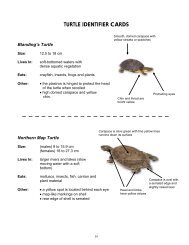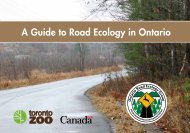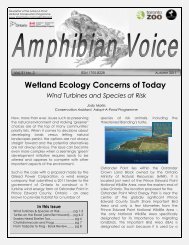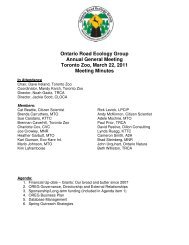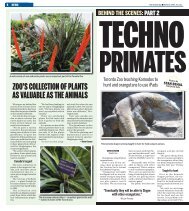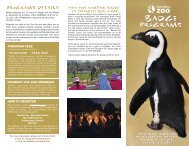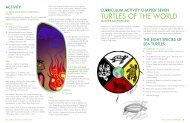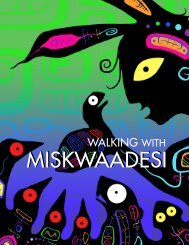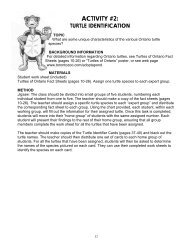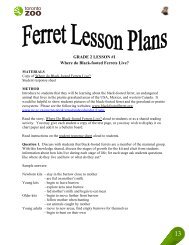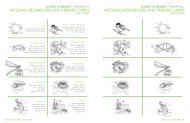Raising Awareness and Reducing Speeds - Toronto Zoo
Raising Awareness and Reducing Speeds - Toronto Zoo
Raising Awareness and Reducing Speeds - Toronto Zoo
Create successful ePaper yourself
Turn your PDF publications into a flip-book with our unique Google optimized e-Paper software.
Protecting Turtles on Roads:<br />
<strong>Raising</strong> <strong>Awareness</strong> <strong>and</strong> <strong>Reducing</strong> <strong>Speeds</strong><br />
Duncan Smith, Kejimkujik National Park <strong>and</strong> National Historic Site
Overview<br />
• Background Info (quick <strong>and</strong> dirty)<br />
• Turtles of Nova Scotia<br />
• Bl<strong>and</strong>ing’s Turtle<br />
• Protecting Turtles on Our Roads<br />
• Rationale<br />
• Implementation<br />
• Evaluation Mechanisms<br />
• Next Steps
Turtles of Nova Scotia<br />
Q: What are the 4 freshwater turtles in Nova Scotia?<br />
Eastern Painted Turtle<br />
© Duncan Smith<br />
Common Snapping Turtle<br />
Wood Turtle<br />
unknown<br />
© Duncan Smith<br />
Bl<strong>and</strong>ing’s Turtle
The Bl<strong>and</strong>ing’s Turtle<br />
Q: What is the status of the Bl<strong>and</strong>ing’s Turtle in Nova Scotia?<br />
A: Endangered<br />
Q: What is the estimated population size in Nova Scotia?<br />
A: 300 adults<br />
© Duncan Smith
Protecting Turtles on Our Roads<br />
1. Turtles are killed by cars on our roads every year.<br />
• Adult females nest on the roadsides each year<br />
• 5 of 35 known breeding females in Kejimkujik<br />
nest on the roadsides.<br />
• 3 of 38 adult females killed in less than one<br />
generation (almost 10%)<br />
• Each year, more than 60% of hatchlings from a single<br />
roadside nest may be car casualties<br />
2. Female Bl<strong>and</strong>ing’s turtles have specific nesting areas<br />
• Designated Bl<strong>and</strong>ing’s turtle critical habitat - essential for the survival<br />
of the species they receive Kejimkujik’s highest level of protection.
• Critical Habitat was partially delineated in 2006<br />
• Mapped out “Turtle Zones” on Keji’s Roads<br />
• Developed a strategy which focused on actions <strong>and</strong> education<br />
• Actions<br />
• Education:<br />
Protecting Turtles on Our Roads<br />
- Seasonal sign <strong>and</strong> speed bump placement<br />
- Evaluation of effectiveness (actions & education)<br />
- Developed key messages<br />
- Designed marketing tools<br />
“Give Turtles a Brake!”
Turtle Zones<br />
Type 1 – significant nesting area<br />
for painted or snapping turtles<br />
Measures:<br />
• generic turtle sign<br />
Type 2 – Bl<strong>and</strong>ing’s nesting sites<br />
Measures:<br />
• signage that explicitly states<br />
“endangered species nesting area”<br />
• J-Line: reduce speed to 20km/hr<br />
with signs <strong>and</strong> speed bumps.
Education: Key Messages<br />
1. Turtle Zones are areas frequently used by female turtles for nesting. Turtle signs<br />
mean: slow down, watch carefully <strong>and</strong> stay on the pavement.<br />
2. What to watch for:<br />
• In June, female Bl<strong>and</strong>ing’s turtles nest<br />
on the roadside<br />
• In September <strong>and</strong> October, tooniesized<br />
hatchlings are on the pavement<br />
© Norm Green, Friends of Keji<br />
3. The federal Species At Risk Act legally protects Bl<strong>and</strong>ing’s turtles <strong>and</strong> their habitat.<br />
There are very substantial fines for individuals who purposefully or negligently disturb or<br />
destroy these turtles or their habitat.<br />
4. YOU can help protect Bl<strong>and</strong>ing’s turtles<br />
Respecting turtle zones, reporting sightings to park staff <strong>and</strong> getting involved with recovery<br />
activities – you can help protect this endangered species.
Education: Marketing<br />
Marketing:<br />
• T-shirts<br />
• Bumper Stickers<br />
• Visitor Guide<br />
• Small Signs (future)
Evaluating Success<br />
Quantitative Evaluation Methods<br />
• Number of turtles hit by cars<br />
• Number of people contacted through programs<br />
• Quantity of Merch<strong>and</strong>ise distributed<br />
• Number of questions asked about Turtle Zones<br />
Qualitative Evaluation Methods<br />
• Measure the audiences knowledge of the projects key messages<br />
• Determine changes in driving behaviour
Evaluating Success: : Knowledge<br />
n = 163
Evaluating Success: Behaviour
Next Steps<br />
• Enhance Protection of Bl<strong>and</strong>ing’s Turtle Sites in the fall<br />
• Proposed Options to date:<br />
• Tunnels / Fences to limit<br />
movement<br />
• Hatchling specific media<br />
• Headstart hatchlings<br />
• Move hatchlings<br />
• A combination of the above?<br />
© Jan Bell, Friends of Keji
Next Steps<br />
• Develop Protection Mechanisms<br />
for Outside Kejimkujik<br />
• Proposed Options to date:<br />
• Work with Communities<br />
• Work with DOT<br />
• Signs<br />
• Habitat Modifications<br />
• What we discover here!
Special Thanks<br />
Brennan Caverhill<br />
Stephen Flemming<br />
Tom Herman<br />
Jeffie McNiel<br />
Friends of Keji Cooperating Association<br />
The Bl<strong>and</strong>ing’s Turtle Recovery Team<br />
The Parks Canada Species at Risk Recovery Action<br />
<strong>and</strong> Education Fund (SARRAEF)
Contact Information<br />
Duncan.smith@pc.gc.ca<br />
Kejimkujik National Park <strong>and</strong> National Historic Site<br />
Box 236, Maitl<strong>and</strong> Bridge<br />
Nova Scotia, B0T 1B0<br />
All photos copyright Parks Canada unless stated otherwise.


